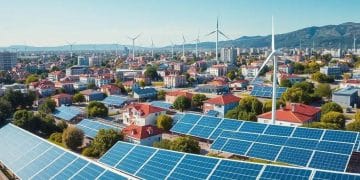Updates on climate change policies and action you should know

Updates on climate change policies and action highlight the global commitment to stricter regulations, net-zero targets, and the integration of renewable energy technologies to mitigate climate impacts effectively.
Updates on climate change policies and action are essential as they shape our environment and future. Are you aware of the latest changes that could affect your community? Let’s dive in to explore these developments.
Recent changes in international climate agreements
Recent changes in international climate agreements are vital to understanding global efforts in combating climate change. These agreements aim to create a framework for countries to work together, reducing emissions and promoting sustainability. Let’s take a closer look at these changes and their implications.
Key international agreements
Several significant international agreements play a crucial role in guiding climate action. Here are some of the most notable:
- The Paris Agreement: A landmark deal adopted in 2015, aiming to limit global warming to well below 2 degrees Celsius.
- Kyoto Protocol: An earlier agreement focusing on binding emissions targets for developed countries.
- Glasgow Climate Pact: Established at COP26, this pact emphasizes urgent and ambitious actions from all countries.
These agreements demonstrate the global commitment to confronting climate change. As nations come together, they set ambitious targets to lower greenhouse gas emissions and transition to renewable energy sources.
Recent changes
Recently, many countries have updated their commitments, pledging to enhance their targets. Both developed and developing nations are recognizing the need for stronger action. For instance, some countries are pledging to achieve net-zero emissions by 2050, while others are committing to specific interim targets.
In addition to emissions reduction goals, funding for climate adaptation and mitigation has become a focus of new discussions. Countries are increasingly acknowledging the support needed for developing nations to address the impacts of climate change effectively. This support is crucial in fostering global cooperation.
As these changes unfold, it’s essential for all stakeholders to stay informed. Being aware of international climate agreements helps individuals understand their country’s role in the global climate strategy. This understanding can empower citizens to contribute to climate solutions and advocate for sustainable practices.
In conclusion, understanding the recent changes in international climate agreements is not just for policymakers; it affects everyone. By promoting transparency and engagement, we can work together towards a sustainable future.
Impact of climate policies on local communities
The impact of climate policies on local communities is profound and multifaceted. These policies can influence various aspects of daily life, from job opportunities to health outcomes. Understanding these effects helps communities prepare and adapt to changes brought by such policies.
Economic changes
One significant impact of climate policies is on local economies. Regulations aimed at reducing emissions can create new job opportunities in green industries.
- Renewable energy jobs: As communities shift towards sustainable energy sources, many jobs in solar and wind industries are created.
- Energy efficiency programs: Policies promoting energy efficiency can lead to jobs in retrofitting homes and buildings.
- Local investments: Money spent on clean technologies stimulates local economies and businesses.
However, these changes can also disrupt traditional industries, like fossil fuels, leading to job losses if not managed wisely. It is crucial for communities to balance these transitions effectively.
Social implications
Beyond economics, climate policies can have significant social effects. Communities may find improvements in public health as air and water quality enhance due to reduced pollution. This is particularly important for vulnerable populations who often bear the brunt of environmental issues.
Local engagement in climate action fosters a sense of community, as residents collaborate on sustainability initiatives. Programs such as community gardens and local clean-up days highlight how policy changes can bring people together, promoting a shared commitment to the environment.
Moreover, climate policies can also create disparities. Low-income communities may not have the same resources to adapt to changes. Ensuring **equity** in climate action is essential to avoid leaving anyone behind.
With the right support and resources, local communities can thrive under new climate policies. As they adapt to changes, they contribute positively to the overall goal of a sustainable future.
Innovative actions by governments worldwide

Innovative actions by governments worldwide are shaping the future of climate policies. Many nations are taking bold steps to address climate change, showcasing creativity and determination in their approaches. These actions span a range of initiatives that inspire other countries and communities to follow suit.
Renewable energy investments
Governments across the globe are investing heavily in renewable energy sources. This shift not only helps reduce greenhouse gas emissions but also promotes energy independence. Here are some examples of these innovative efforts:
- Solar energy initiatives: Countries like Germany and China lead in solar power, implementing large-scale solar farms.
- Wind energy projects: The United States and Denmark have established extensive offshore wind farms that generate substantial electricity.
- Innovative financing: Some governments, such as those in Scandinavia, are using green bonds to fund sustainable projects.
These investments demonstrate a commitment to building a sustainable future while creating new jobs in the green sector.
Community engagement programs
In addition to energy initiatives, governments are also fostering community engagement in climate action. By involving citizens, they create a sense of responsibility and ownership. Engaging the public leads to more effective and accepted policies.
Programs that encourage local participation in climate solutions include city-wide tree planting events and educational campaigns on energy conservation. These actions empower communities while promoting environmental stewardship.
Moreover, innovative policies such as carbon pricing have emerged as a means to encourage businesses to lower emissions. By placing a financial cost on carbon emissions, governments incentivize companies to seek greener alternatives and invest in sustainable technologies.
As we observe these innovative actions by governments, it becomes clear that collaborative efforts can lead to significant progress in the fight against climate change. Countries that embrace these strategies will not only contribute to global efforts but also reap economic and social benefits.
Role of technology in climate change response
The role of technology in climate change response is increasingly significant. As the world faces the challenges of climate change, technological advancements are providing innovative solutions to reduce emissions, improve energy efficiency, and support sustainable practices.
Renewable energy technologies
One of the most impactful areas of technology is in renewable energy sources. Innovations in solar, wind, and hydroelectric power are transforming how energy is produced. The development of more efficient solar panels and wind turbines has made renewable energy more accessible and cost-effective.
- Solar advancements: New photovoltaic materials are being developed, increasing the efficiency of solar energy capture.
- Wind energy improvements: Larger and more efficient turbines are being installed, allowing for greater energy production.
- Energy storage solutions: Advances in battery technology are enabling better storage of energy generated by renewables, addressing reliability issues.
These advancements not only help in reducing carbon footprints but also create a new sector of jobs focused on green technologies.
Smart technologies for efficiency
Another crucial advancement is the use of smart technologies in monitoring and managing energy consumption. Smart grids allow for real-time data collection and management, enhancing energy efficiency.
Home automation systems help residents optimize their energy use, such as adjusting heating and cooling systems based on usage patterns. Additionally, smart meters provide consumers with information about their energy consumption, encouraging behaviors that reduce waste.
Another technological innovation is the generation of climate models using artificial intelligence and machine learning. These models offer valuable insights about climate patterns and impacts, helping policymakers make informed decisions about climate action.
Overall, combining these technologies leads to lower emissions, improved energy management, and a more sustainable future. The role of technology in climate change response is not just supportive; it is essential for achieving global climate goals.
Future outlook for climate change legislation
The future outlook for climate change legislation is critical as the world faces escalating climate challenges. Many governments are recognizing the urgency of implementing effective laws and policies to combat climate change.
Predicted trends in legislation
In the coming years, we can expect significant trends in climate change legislation globally. Countries are likely to introduce more stringent regulations to meet international climate commitments.
- Net-zero targets: Many nations are setting mandatory deadlines to achieve net-zero emissions, pushing industries to adopt cleaner technologies.
- Carbon pricing: More jurisdictions will likely implement carbon taxes or cap-and-trade systems to hold companies accountable for their emissions.
- Incentives for renewables: Legislation will increasingly favor renewable energy sources, providing subsidies and incentives to accelerate the transition from fossil fuels.
These expected legislative changes reflect a global shift towards sustainability, aiming for a greener future.
International collaboration
As climate change knows no borders, international collaboration will play a key role in shaping future climate legislation. Countries will need to work together to create agreements that address shared challenges.
Events like climate summits will facilitate negotiations and partnerships, allowing nations to align their strategies. A united approach will help ensure that all countries contribute fairly toward global climate goals.
Emerging technologies will also play a vital role in supporting legislation. Innovations in carbon capture, energy efficiency, and sustainable agriculture will make it easier for countries to implement and achieve their climate targets.
While the road ahead may be challenging, the integration of climate change legislation into broader policy frameworks is indispensable. As communities push for action, the future of climate change legislation looks promising, driven by the collective urgency to protect our planet.
FAQ – Frequently Asked Questions about Climate Change Legislation
What are net-zero targets?
Net-zero targets are commitments made by countries to balance the amount of greenhouse gases emitted with the amount removed from the atmosphere by a specific date.
How does carbon pricing work?
Carbon pricing puts a financial cost on carbon emissions, encouraging companies to reduce their carbon footprint and invest in cleaner technologies.
Why is international collaboration important in climate action?
International collaboration is crucial because climate change is a global issue that requires countries to work together to achieve meaningful and effective results.
What role does technology play in addressing climate change?
Technology provides innovative solutions like renewable energy sources and smart systems that enhance energy efficiency and help monitor emissions, contributing significantly to climate change mitigation.





